Friday, June 4th 2010

ASUS Displays ROG Immensity Concept Motherboard
ASUS showed off a unique motherboard concept part of its Republic of Gamers series, the ROG Immensity. This socket LGA-1366 motherboard comes with onboard graphics, using a discrete ATI Radeon HD 5000 series GPU with dedicated GDDR3 memory. While the Intel X58 Express + ICH10R chipset are very much there, the X58 is wired to a Lucid Hydra Engine chip, which drives both the PCI-Express 2.0 x16 slots. It is probably also connected to the ATI Radeon GPU, giving users the ability to stay connected to the on board GPU, while 3D graphics is accelerated from any graphics card plugged in to the PCI-E slots, of any make, and in any combination (including NVIDIA + ATI). The Hydra chip handles the load-balancing between the GPUs depending on their computation power and features available.
Apart from this unique feature, the ROG Immensity is designed for extreme overclocking, making use of an 8-phase PWM circuit with additional stabilizers and power conditioning using super-ML capacitors. Memory is powered by a 6-phase PWM circuit with its own power-conditioning super-ML capacitor. All ROG-exclusive features such as iROG and ROG-Connect are present. Connectivity features include SATA 3 Gb/s RAID, two SATA 6 Gb/s ports, USB 3.0, Bluetooth, gigabit Ethernet, and 8-channel audio. Four PCI-E x1 slots make for the rest of the expansion. For now ASUS chooses to call this a concept design, so it's uncertain whether it will release it to market any time soon.
Apart from this unique feature, the ROG Immensity is designed for extreme overclocking, making use of an 8-phase PWM circuit with additional stabilizers and power conditioning using super-ML capacitors. Memory is powered by a 6-phase PWM circuit with its own power-conditioning super-ML capacitor. All ROG-exclusive features such as iROG and ROG-Connect are present. Connectivity features include SATA 3 Gb/s RAID, two SATA 6 Gb/s ports, USB 3.0, Bluetooth, gigabit Ethernet, and 8-channel audio. Four PCI-E x1 slots make for the rest of the expansion. For now ASUS chooses to call this a concept design, so it's uncertain whether it will release it to market any time soon.
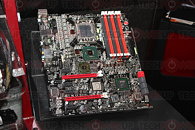
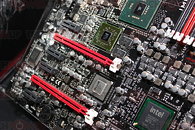
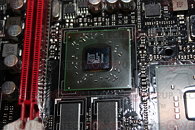
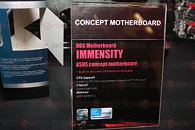
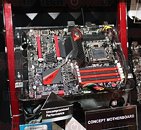
23 Comments on ASUS Displays ROG Immensity Concept Motherboard
Love the Lucid Hydra. Wish they started adding this ability to more of their board range.
Barr
Lucid Logix Hydra: performance is only as good as the drivers, which are crap (to put it kindly) and will never be as good as the GPU vendors' drivers.
integrated ATI GPU: why? Last time I checked, people who spend a lot of money X58 boards don't want or need integrated graphics, since they also spend a lot of money on discrete graphics and don't really care about power/heat. If this was an nVidia GPU I could understand as it could be used for PhysX, but it's not.
2x full-length PCI-E slots: yay, you can 1 ATI and 1 nVidia card in tandem... so why not just go for SLI or Crossfire to get the best performance?
In short, I can't see any purpose for this board to exist except as a marketing gimmick. There are many other X58 boards out there that offer more useful features at a lower price point.
techreport.com/articles.x/17934/3
Though I wish they integrate nvidia gpu instead to handle the miscellaneous stuff like physx and cuda (the least important one) and let us use ATi as the main discreet card. :/
This is clearly marketed towards the enthusiast
A mid to low end GPU, even with the hydra, can't add that much more performance to the equation when using high end parts
The presence of the discrete chip means more board complexity, more power requirements, and less space for other 'enthusiast' features (like another PCI-E x16 slot)
In the end, because of the additional stuff on the board, there's a chance that overclocking performance would actually be worse than without it
I'm just not sure why they'd introduce this on this high end board - even if it is only a concept. This kind of feature would be more useful on a slimline HTPC board, or if it had a nVidia GPU, at least it could be used to accelerate PhysX. Unless ASUS knows something we don't about ATi GPU computing acceleration, there just doesn't seem to be a good reason to have this combination of stuff.
Example: My friend's GTX 280 died about 4 days ago, and he doesn't have any money to get any graphics card at the moment. All he has right now is his netbook. If he had a board with a discrete GPU like this (since you can't get an IGP on high end boards or processors currently), he would still be able to play WoW, TF2, etc. at moderate settings.
Not everyone possesses extra parts or money all the time to keep their rigs going.